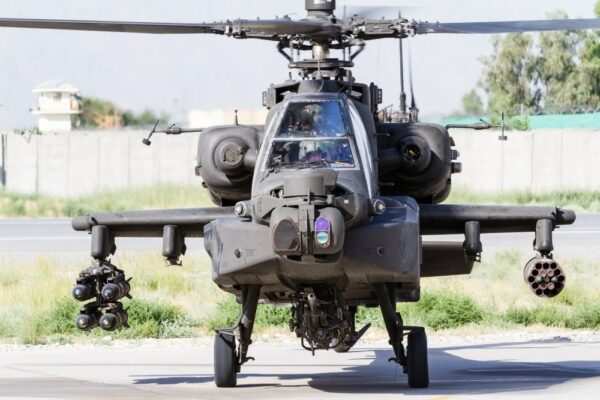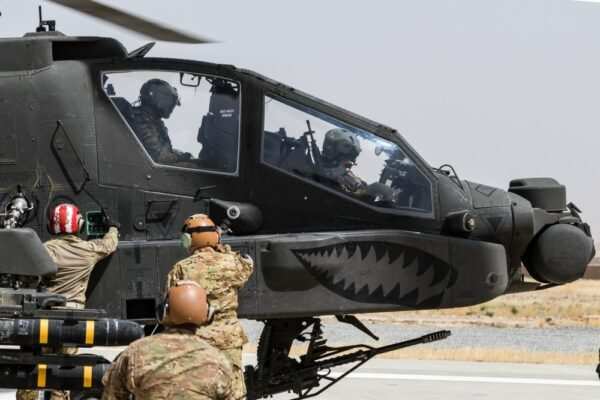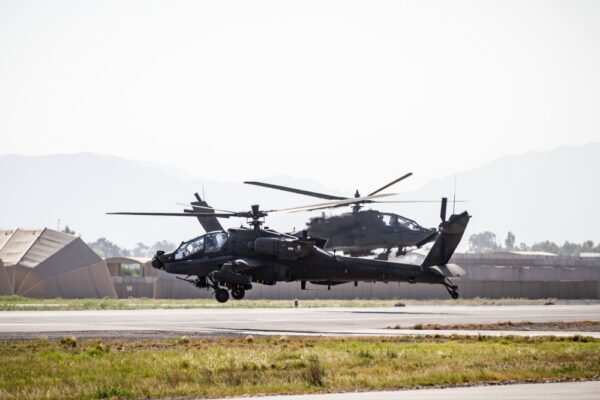The Apache is one of the U.S. military’s most recognizable helicopters. Like the M1 Abrams tank and the F-15E Strike Eagle fighter, the Apache was one of the weapon systems implemented in the 1980s and proved vital in the 1991 Gulf War.
The time-tested Apache has had numerous variants over the years. The AH-64E “Guardian” is one of those variants.

U.S. Army AH-64E Apache helicopter pilots assigned to Task Force Tigershark, 16th Combat Aviation Brigade, 7th Infantry Division prepare to depart for a mission at Jalalabad Airfield, Afghanistan, June 12, 2017. The Tigersharks provide aviation support to U.S. Forces Afghanistan as part of Operation Freedom’s Sentinel. (Capt. Brian Harris/U.S. Army)
The AH-64E Guardian is the latest Apache variant and expected to be the final variant that carries the Apache’s service through the year 2040. It was approved in 2012 – 15 years after its preceding variant, the AH-64D Longbow.
The Longbow’s feature upgrade included an APG-78 radar atop the rotor, granting the ability to both detect and fire at targets on the ground, but out of sight. However, the upgrade increased the Apache’s weight by a significant 15 percent, and the variant didn’t include any engine power upgrades that would compensate for the extra weight.
Take a look at the revolutionary Apache AH-64E below:
The AH-64E added “more powerful T700-GE-701D turboshaft engines, a modern face gear transmission system, and new composite rotor blades—increasing the AH-64E’s speed from 140 to 180 miles per hour,” according to National Interest.
It also included a Manned-Unmanned Team (MUM-T) drone controller datalink, which allows a copilot to control a nearby MQ-1C Grey Eagle drone, and receive data from it, giving the Apache teams critical target area information before arriving to the location.
Lt. Col. John Davis, commander of the 1st Battalion, 229th Aviation Regiment, part of the 16th Combat Aviation Brigade at Joint Base Lewis McCord in Washington, told Military.com that his unit operated both the Apache’s Longbow and Guardian variants together in Afghanistan in 2014 for nearly 11,000 hours over a seven month tour. His unit noted distinct differences between the two.
The Guardian included “digital cockpit avionics, more powerful engines and composite rotor blades, among other features that improve the aircraft’s range and loitering ability,” Davis said.

U.S. Army AH-64E Apache pilots assigned to Task Force Griffin, 16th Combat Aviation Brigade, 7th Infantry Division prepare to depart for a mission in Kunduz, Afghanistan, May 31, 2017. The Griffins are working hard to support U.S. Forces Afghanistan as part of Operation Freedom’s Sentinel and Resolute Support Mission. (Capt. Brian Harris/U.S. Army)
The Guardian traveled at 155 knots – 178 miles per hour – and reduced the time required to travel to the front line by 57 percent. The Longbow traveled 125 knots, or 143 miles per hour.
Davis said the increased fuel economy of the Guardian proved confusing to the enemy, who learned to track the Longbow model by its frequent refueling habits.

U.S. Army AH-64E Apache helicopter pilots assigned to Task Force Tigershark, 16th Combat Aviation Brigade, 7th Infantry Division depart for a mission at Jalalabad Airfield, Afghanistan, April 25, 2017. TF Tigershark is supporting Train, Advise and Assist Command – East and U.S. Forces Afghanistan as part of Operation Freedom’s Sentinel. (Capt. Brian Harris/U.S. Army)
The Guardian also featured Ground-Fire Acquisition Systems, a technology that uses cameras to surveil the battlefield and identifies muzzle flashes that enables the crew to quickly fire upon confirmed enemy locations.
The Guardian has proven to be such a battlefield success the Army plans to upgrade 634 Apaches to the latest variant, as well as produce dozen more new models. Other nations have also followed suit and have also added Apache Guardians to their fleets, or plan to upgrade their Longbow variants.



